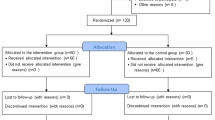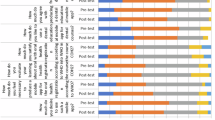Key Points
-
Reviews the latest developments in mobile devices, mobile apps and health apps.
-
Raises awareness of the potential of a mobile app to motivate and inform patients.
-
Highlights the use of music to motivate toothbrushing for longer.
-
Innovative tool to raise awareness of Delivering Better Oral Health toolkit information to the public.
Abstract
Introduction Mobile apps are software programmes that run on smartphones and other mobile devices. Mobile health apps can help people manage their own health and wellness, promote healthy living and gain access to useful information when and where they need it. The Brush DJ oral health app was developed to use the opportunity mobile apps offer to motivate an evidence-based oral hygiene routine. A literature review has found no research investigating the use of a mobile app to motivate evidence-based oral hygiene behaviour.
Objective The objective of this preliminary investigation was to assess user perception of an oral health app to give a basis for future research and development of app technology in relation to oral health.
Method A cross-sectional qualitative user perception questionnaire.
Results One hundred and eighty-nine people responded to the questionnaire. Seventy percent (n = 113) of respondents reported that their teeth felt cleaner since using the app. Eighty-eight percent (n = 133) reported the app motivated them to brush their teeth for longer and 92.3% (n = 144) would recommend the app to their friends and family. Four broad themes relating to how the app helped toothbrushing were reported. These themes were motivation, education, compliance and perceived benefits.
Conclusion A mobile app is a promising tool to motivate an evidence-based oral hygiene routine.
Similar content being viewed by others
Log in or create a free account to read this content
Gain free access to this article, as well as selected content from this journal and more on nature.com
or
References
US Food and Drug Administration. Mobile medical applications. Online information available at http://www.fda.gov/medicaldevices/productsandmedicalprocedures/connectedhealth/mobilemedicalapplications/default.htm (accessed June 2015).
Fiegerman S . Apple app store tops 75 billion downloads. 2009. Online information available at http://mashable.com/2014/06/02/apple-app-store-stats-2014/ (accessed June 2015).
Apple. IPhone 3G on sale tomorrow. 2008. Online information available at https://www.apple.com/uk/pr/library/2008/07/10iPhone-3G-on-Sale-Tomorrow.html (accessed June 2015).
Fiegerman S . Google play passes 50 billion app downloads. 2013. Online information available at http://mashable.com/2013/07/18/google-play-50-billion-apps/ (accessed June 2015).
Eadicicco L . Apple has shipped 1 billion iOS devices. 2015. Online information available at http://uk.businessinsider.com/apple-ships-one-billion-ios-devices-2015-1 (accessed June 2015).
Gartner . Gartner says tablet sales continue to be slow in 2015. 2015. Online information available at http://www.gartner.com/newsroom/id/2954317 (accessed June 2015).
Sparkes M . Should the £26 Indian smartphone worry Apple? 2014. Online information available at http://www.telegraph.co.uk/technology/mobile-phones/10995383/Should-the-26-Indian-smartphone-worry-Apple.html (accessed June 2015).
Ericsson. Ericsson mobility report. 2013. Online information available at http://www.ericsson.com/res/docs/2013/ericsson-mobility-report-november-2013.pdf (accessed June 2015).
Farmer A . A third of mobile-owning teens also 'own' a tablet. 2014. Online information available at https://yougov.co.uk/news/2014/02/04/third-mobile-owning-teens-also-own-tablet/ (accessed June 2015).
Ofcom. The communications market report: UK. 2014. Online information available at http://stakeholders.ofcom.org.uk/market-data-research/market-data/communications-market-reports/cmr14/ (accessed June 2015).
Garside J . Ofcom: sixyearolds understand digital technology better than adults. 2014. Online information available at http://www.theguardian.com/technology/2014/aug/07/ofcom-children-digital-technology-better-than-adults (accessed June 2015).
Ofcom. One in three children now has their own tablet computer. 2014. Online information available at http://consumers.ofcom.org.uk/news/one-in-three-children-have-own-tablet/ (accessed June 2015).
Jahns R . 500m people will be using healthcare mobile applications in 2015. 2010. Online information available at http://research2guidance.com/500m-people-will-be-using-healthcare-mobile-applications-in-2015/ (accessed June 2015).
PwC. Emerging mHealth: paths for growth. 2014. Online information available at https://www.pwc.com/gx/en/healthcare/mhealth/assets/pwc-emerging-mhealth-full.pdf (accessed June 2015).
Klasnja P, Pratt W . Healthcare in the pocket: mapping the space of mobile-phone health interventions. J Biomed Inform 2012; 45: 184–198.
Gruman J . An open letter to mobile health app developers and their funders. 2013. Online information available at http://www.cfah.org/blog/2013/an-open-letter-to-mobile-health-app-developers-and-their-funders (accessed June 2015).
Demidowich A P, Lu K, Tamler R, Bloomgarden Z . An evaluation of diabetes self-management applications for Android smartphones. J Telemed Telecare. 2012; 18: 235–238.
Huckvale K, Car M, Morrison C, Car J . Apps for asthma self-management: a systematic assessment of content and tools. BMC Med 2012; 10: 144.
Kristjánsdóttir O B, Fors E A, Eide E et al. A smartphone-based intervention with diaries and therapist-feedback to reduce catastrophising and increase functioning in women with chronic widespread pain: randomised controlled trial. J Med Internet Res 2013; 15: e5.
Wolf J A, Moreau J, Akilov O et al. Diagnostic inaccuracy of smartphone applications for melanoma detection. JAMA Dermatol 2013; 149: 422–426.
Department of Health. Dental quality and outcomes framework. 2011. https://www.gov.uk/government/uploads/system/uploads/attachment_data/file/216300/dh_126627.pdf (accessed June 2015).
Health and Social Care Information Centre. Monthly topic of interest: children in hospital episode statistics - July 2012 to June 2013, provisional. 2014. http://www.hscic.gov.uk/catalogue/PUB11758/prov-mont-hes-admi-outp-ae-apr-jun-13-14-toi-rep.pdf (accessed June 2015).
Steele J G, O'Sullivan I . Executive summary: adult dental health survey 2009. 2011. Online information available at http://www.dhsspsni.gov.uk/adhexecutivesummary.pdf (accessed June 2015).
Public Health England. Delivering better oral health: an evidence based toolkit for prevention. 2014. Online information available at https://www.gov.uk/government/uploads/system/uploads/attachment_data/file/367563/DBOHv32014OCTMainDocument_3.pdf (accessed June 2015).
Chadwick b, White D, Lader D, Pitts N . Preventive behaviour and risks to oral health - a report from the Adult Dental Health Survey 2009. 2011. Online information available at http://www.dhsspsni.gov.uk/theme5_preventivebehaviourandriskstooralhealth.pdf (accessed June 2015).
British Dental Health Foundation. Nearly half skip brushing teeth at bedtime. 2011. Online information available at http://www.dentalhealth.org/news/details/483 (accessed June 2015).
Clemens C, Taylor S . Toothbrushing to music. Dent Hyg (Chic) 1980; 54: 125–126.
NHS Smokefree. SmokeFree. Online information available at www.nhs.uk/smokefree (accessed June 2015).
NHS Choices. Healthy eating. Online information available at http://www.nhs.uk/livewell/healthy-eating/Pages/Healthyeating.aspx (accessed June 2015).
NHS Choices. Drinking and alcohol. Online information available at http://www.nhs.uk/Livewell/alcohol/Pages/Alcoholhome.aspx (accessed June 2015).
YouTube. Brush DJ videos. Online information available at https://www.youtube.com/user/brush3000/videos?view=0 (accessed June 2015).
iTunes. Brush DJ, version 3.0. 2015. Online information available at https://itunes.apple.com/gb/app/brush-dj/id475739913?mt=8 (accessed June 2015).
Google Play. Brush DJ, version 3.0. 2015. Online information available at https://play.google.com/store/apps/details?id=uk.co.appware.brushdj&hl=en (accessed June 2015).
NHS Choices Health App Library. Brush DJ. Online information available at http://apps.nhs.uk/app/brush-dj/ (accessed June 2015).
NHS Choices Health App Library. About. Online information available at http://apps.nhs.uk/about/ (accessed June 2015).
SurveyMonkey. Home. Online information available at https://www.surveymonkey.com (accessed June 2015).
Medical Research Council. Is my study research? Online information available at http://www.hra-decisiontools.org.uk/research/index.html (accessed June 2015).
Moore D L, Tarnai J . Evaluating nonresponse error in mail surveys. In Groves R M, Dillman D A, Eltinge J L A, Little R J A (eds) Survey nonresponse. pp 197–211. New York: Wiley, 2002.
Beals D, Ngo T, Feng Y, Cook D, Grau D G, Weber D A . Development and laboratory evaluation of a new toothbrush with a novel brush head design. Am J Dent 2000; 13: 5A–14A.
Creeth J E, Gallagher A, Sowinski J et al. The effect of brushing time and dentifrice on dental plaque removal in vivo. J Dent Hyg 2009; 83: 111–6.
Karageorghis C I, Priest D L . Music in sport and exercise: an update on research and application. 2008. Online information available at http://thesportjournal.org/article/musicsportandexerciseupdateresearchand-application/ (accessed June 2015).
Picker Institute Europe. Policy briefing: the friends and family test. 2014. Online information available at http://www.pickereurope.org/wp-content/uploads/2014/11/PIEReport-FFTFinalReport.pdf (accessed June 2015).
Schnellinger M, Finkelstein M, Thygeson M V, Vander Velden H, Karpas A, Madhok M . Animated video vs pamphlet: comparing the success of educating parents about proper antibiotic use. Pediatrics 2010; 125: 990–996.
Qmee. Online in 60 seconds [infographic] - a year later. Online information available at http://blog.qmee.com/online-in-60-seconds-infographic-a-year-later/ (accessed June 2015).
Cowan L T, Van Wagenen S A, Brown B A et al. Apps of steel: are exercise apps providing consumers with realistic expectations?: a content analysis of exercise apps for presence of behavior change theory. Health Educ Behav 2013; 40: 133–9.
Michie S, Richardson M, Johnston M et al. The behavior change technique taxonomy (v1) of 93 hierarchically clustered techniques: building an international consensus for the reporting of behavior change interventions. Ann Behav Med 2013; 46: 81–95.
Hashemian T S, Kritz-Silverstein D, Baker R . Text2Floss: the feasibility and acceptability of a text messaging intervention to improve oral health behavior and knowledge. J Public Health Dent 2014; 75: 34–41.
Kozelka M . The key to better health care may already be in your pocket...and it's not your wallet. 2013. http://rockcenter.nbcnews.com/_news/2013/01/24/16677207-the-key-to-better-health-care-may-already-be-in-your-pocket-and-its-not-your-wallet (accessed June 2015).
Federal Communications Commission. Lifeline program for low-income consumers. Online information available at http://www.fcc.gov/lifeline (accessed June 2015).
Centers for Disease Control and Prevention. Disparities in oral health. Online information available at http://www.cdc.gov/oralhealth/oral_health_disparities/index.htm (accessed June 2015).
Couper M P . Designing effective web surveys. New York: Cambridge University Press; 2008.
Choi B C K, Pak AWP . A catalog of biases in questionnaires. 2005. Online information available at http://www.cdc.gov/pcd/issues/2005/jan/04_0050.htm (accessed June 2015).
Acknowledgements
Appware Ltd for the development of the Brush DJ app and Jason Atkinson for his advice.
Author information
Authors and Affiliations
Corresponding author
Ethics declarations
Competing interests
Ben Underwood is the owner of the Brush DJ app.
Additional information
Refereed Paper
Rights and permissions
About this article
Cite this article
Underwood, B., Birdsall, J. & Kay, E. The use of a mobile app to motivate evidence-based oral hygiene behaviour. Br Dent J 219, E2 (2015). https://doi.org/10.1038/sj.bdj.2015.660
Accepted:
Published:
Issue date:
DOI: https://doi.org/10.1038/sj.bdj.2015.660
This article is cited by
-
Mobile app for comprehensive management of orthodontic patients with fixed appliances
Journal of Orofacial Orthopedics / Fortschritte der Kieferorthopädie (2023)
-
Efficacy of a mobile phone application for the improvement of oral hygiene of patients undergoing fixed orthodontic treatment
Journal of Orofacial Orthopedics / Fortschritte der Kieferorthopädie (2023)
-
Smartphone applications as a tool to improve children’s brushing habits
European Archives of Paediatric Dentistry (2023)
-
Study protocol: understanding pain after dental procedures, an observational study within the National Dental PBRN
BMC Oral Health (2022)
-
Children's hospices: an opportunity to put the mouth back in the body
British Dental Journal (2022)



